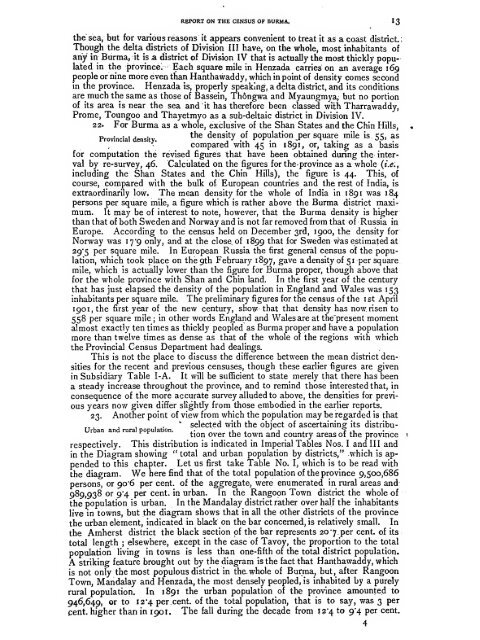Burma: Census of India 1901 Vol. I - Khamkoo
Burma: Census of India 1901 Vol. I - Khamkoo
Burma: Census of India 1901 Vol. I - Khamkoo
Create successful ePaper yourself
Turn your PDF publications into a flip-book with our unique Google optimized e-Paper software.
-<br />
3<br />
REPORT ON THE CENSUS OF BURMA. 1<br />
the sea, but for various reasons it appears convenient to treat it as a coast district.;<br />
Though the delta districts <strong>of</strong> Division III have, on the whole, most inhabitants <strong>of</strong><br />
any in <strong>Burma</strong>, it is a district <strong>of</strong> Division IV that is actually the most thickly populated<br />
in the province/ Each square mile in Henzada carries on an average 169<br />
people or nine more even than Hanthawaddy, which in point <strong>of</strong> density comes second<br />
in the province. Henzada is, properly speaking, a delta district, and its conditions<br />
are much the same as those <strong>of</strong> Bassein, Thongwa and Myaungmya, but no portion<br />
<strong>of</strong> its area is near the sea and it has therefore been classed with Tharrawaddy,<br />
Prome, Toungoo and Thayetmyo as a sub-deltaic district in Division IV.<br />
22. For <strong>Burma</strong> as a whole, exclusive <strong>of</strong> the Shan States and the Chin Hills,<br />
Provincial density.<br />
the<br />
^ty .°f P°Pulation .Per square mile is 55, as<br />
compared with 45 in 1891, or, taking as a basis<br />
for computation the revised figures that have been obtained during the interval<br />
by re-survey, 46. Calculated on the figures for theprovince as a whole (i.e.,<br />
including the Shan States and the Chin Hills), the figure is 44. This, <strong>of</strong><br />
course, compared with the bulk <strong>of</strong> European countries and the rest <strong>of</strong> <strong>India</strong>, is<br />
extraordinarily low. The mean density for the whole <strong>of</strong> <strong>India</strong> in 1891 was 184<br />
persons per square mile, a figure which is rather above the <strong>Burma</strong> district maximum.<br />
It may be <strong>of</strong> interest to note, however, that the <strong>Burma</strong> density is higher<br />
than that <strong>of</strong> both Sweden and Norway and is not far removed from that <strong>of</strong> Russia in<br />
Europe. According to the census held on December 3rd, 1900, the density for<br />
Norway was 17*9 only, and at the close, <strong>of</strong> 1899 tnat f°r Sweden was estimated at<br />
2 9'5 Per square mile. In European Russia the first general census <strong>of</strong> the population,<br />
which took place on the 9th February 1897, gave a density <strong>of</strong> 51 per square<br />
mile, which is actually lower than the figure for <strong>Burma</strong> proper, though above that<br />
for the whole province with Shan and Chin land. In the first year <strong>of</strong> the century<br />
that has just elapsed the density <strong>of</strong> the population in England and Wales was 153<br />
inhabitants per square mile. The preliminary figures for the census <strong>of</strong> the 1st April<br />
<strong>1901</strong>, the first year <strong>of</strong> the new century, show that that density has now risen to<br />
558 per square mile ;<br />
in other words England and Wales are at thVpresent moment<br />
almost exactly ten times as thickly peopled as <strong>Burma</strong> proper and have a population<br />
more than twelve times as dense as that <strong>of</strong> the whole <strong>of</strong> the regions with which<br />
the Provincial <strong>Census</strong> Department had dealings.<br />
This is not the place to discuss the difference between the mean district densities<br />
for the recent and previous censuses, though these earlier figures are given<br />
in Subsidiary Table I-A. It will be sufficient to state merely that there has been<br />
a steady increase throughout the province, and to remind those interested that, in<br />
consequence <strong>of</strong> the more accurate survey alluded to above, the densities for previous<br />
years now given differ slightly from those embodied in the earlier reports.<br />
23. Another point <strong>of</strong> view from which the population may be regarded is that<br />
, .<br />
Urban and rural population.<br />
selected with the object <strong>of</strong> ascertaining its distribu-<br />
'<br />
,<br />
,<br />
L<br />
,<br />
j ? .,<br />
tion over the town and country areas <strong>of</strong> the province 1<br />
respectively. This distribution is indicated in Imperial Tables Nos. I and III and<br />
in the Diagram showing " total and urban population by districts," which is appended<br />
to this chapter. Let us first take Table No. I, which is to be read with<br />
the diagram. We here find that <strong>of</strong> the total population <strong>of</strong> the province 9,500,686<br />
persons, or 90*6 per cent, <strong>of</strong> the aggregate, were enumerated in rural areas and<br />
989,938 or 9"4 per cent, in urban. In the Rangoon Town district the whole <strong>of</strong><br />
the population is urban. In the Mandalay district rather over half the inhabitants<br />
live in towns, but the diagram shows that in all the other districts <strong>of</strong> the province<br />
the urban element, indicated in black on the bar concerned, is relatively small. In<br />
the Amherst district the black section <strong>of</strong> the bar represents 20 'j. per cent, <strong>of</strong> its<br />
total length ;<br />
elsewhere, except in the case <strong>of</strong> Tavoy, the proportion to the total<br />
population living in towns is less than one-fifth <strong>of</strong> the total district population.<br />
A striking feature brought out by the diagram is the fact that Hanthawaddy, which<br />
is not only the most populous district in the- whole <strong>of</strong> <strong>Burma</strong>, but, after Rangoon<br />
Town, Mandalay and Henzada, the most densely peopled, is inhabited by a purely<br />
rural population. In 1891 the urban population <strong>of</strong> the province amounted to<br />
946,649, or to 12*4 per. cent, <strong>of</strong> the total population, that is to say, was 3 per<br />
pent, higher than in 190 1. The fall during the decade from !?"4 to 9*4 per cent.

















